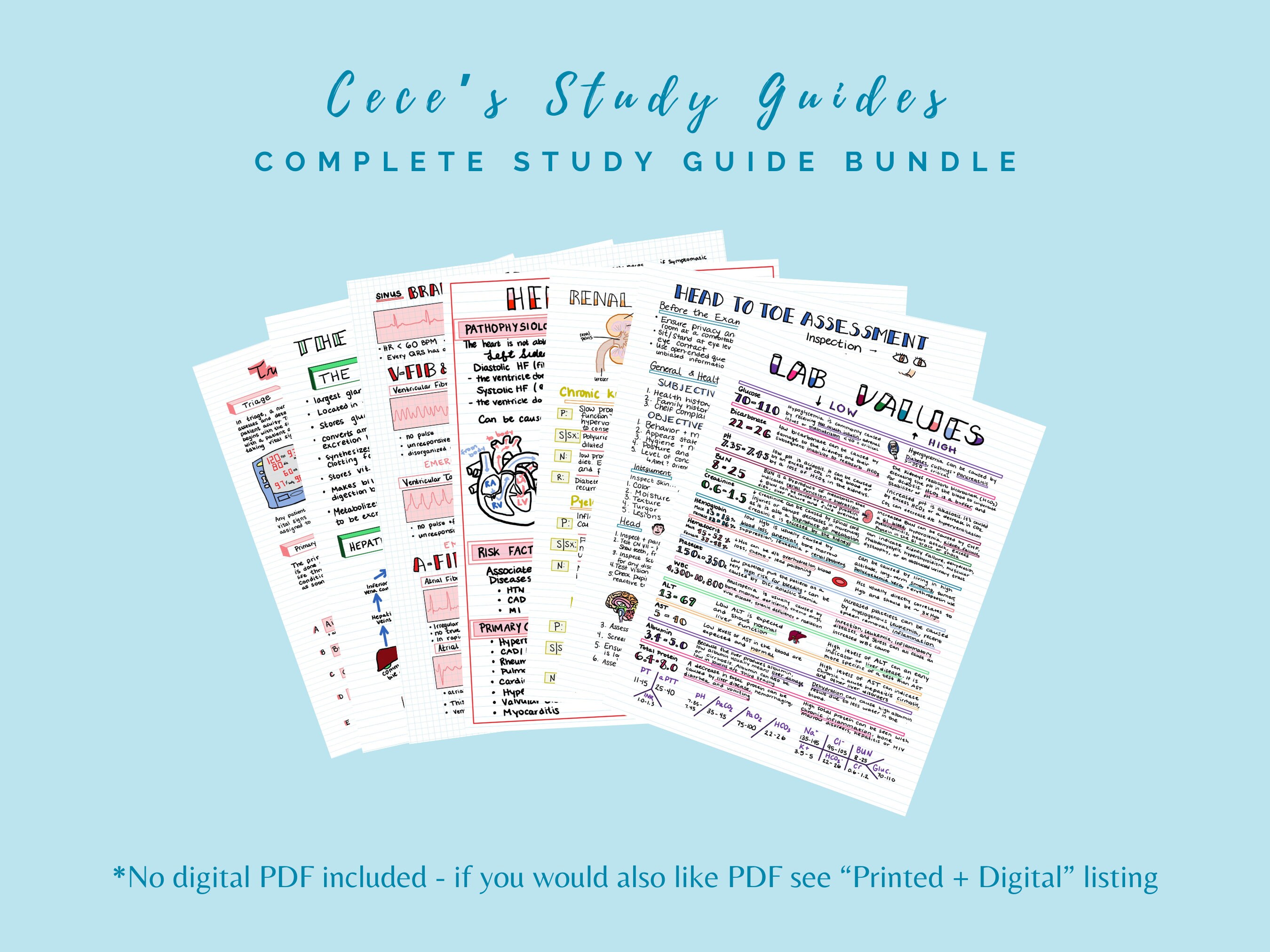***DIGITAL DOWNLOAD: DELIVERED VIA EMAIL***
The study guides included in this bundle add-on are all shops versions of the head-to-toe cheat sheet, head-to-toe expanded guide, dosage calculation guide, med administration guide, ABGs guide, and hemodynamic monitoring (parts 1 & 2) guides. This bundle will have to be emailed to you due to the number of attachments included (Etsy only allows a maximum of 5 for instant downloadable content).
The head-to-toe cheat sheet is a short and sweet, but thorough, version of the steps for completing a head-to-toe assessment. Each page includes graphics for enhanced understanding. Topics covered include introductory steps as well as assessment of the head, face, eyes, nose, ears, mouth, neck, respiratory system, cardiovascular system, abdomen, musculoskeletal system, and integumentary system.
The head-to-toe expanded guide is a 15 page version of our head-to-toe assessment cheat sheet. In the guide, you'll find information about what to do prior to your interaction with the patient as well as how to initiate the interaction to set yourself up for a successful assessment. As far as the examination aspect, each section includes points to cover and when to be concerned. There are graphics to visually enhance your understanding of the content. Topics covered include: head and neck, mental health, neck, chest (heart and lungs), abdomen (GI, renal, reproductive), musculoskeletal, and integumentary systems.
The dosage calculation guide aims to help you master the many different types of pharmacology related dosage calculation questions that might be presented to you while in a nursing program. Within the guide, there are multiple sections including commonly used pharmacology abbreviations, common formulas and conversions, general dosage calculation tips, intravenous medication calculations (Ex: flow rates, drop factors, drip rates, etc.), and five pages of unique practice problems with a key at the end of the guide. The key shows a step by step breakdown of the calculation process and the same method (Dimensional Analysis) is utilized in each problem. There are over 15 pages included in this guide! I am confident that this study guide will help prepare you for success with your dosage calculations.
The med administration guide contains all the introductory pharmacology information every nursing student needs to know in regards to medication administration. Along with key textual information, there are multiple photos/diagrams/tables to present the info in various formats to help enhance your comprehension of the material. The different sections included are: common pharmacology abbreviations, key formulas and conversions, rights of drug administration, different forms and routes for med administration (enteral, rectal, parenteral, percutaneous), an expanded section about injections, and a section on blood glucose testing/insulin injections. This is the perfect resource to review right before clinicals during your first semester!
Our ABG guide includes a list of key abbreviations used, an explanation of normal values, the "ROME" mnemonic, step by step instructions for painless ABG interpretation, an explanation of the buffer system and major organs involved, a breakdown for each of the major states of imbalance, and a simple explanation of the anion gap. Also included in this 20+ page guide are blank worksheets, practice problems, and a key for the practice problems. By the end of this study guide, I am confident that you'll be a pro at ABG interpretation.
The hemodynamic guide has two parts. The first half has nearly 20 pages that cover various methods of monitoring, normal waveforms, and troubleshooting abnormal waveforms. Included methods of hemodynamic monitoring are: arterial lines, CVP lines, pulmonary artery catheter, IABP catheters, and Impella heart pumps. The second half has over 20 pages that cover commonly used abbreviations, various values included when performing hemodynamic monitoring, and a resource list for both parts of the study guide. Values discussed include: HR, BP, pulse pressure, mean arterial pressure (MAP), contractility, preload and afterload, ejection fraction (EF), cardiac output (CO), cardiac index (CI), stroke volume (SV), central venous pressure (CVP), systemic vascular resistance (SVR), pulmonary vascular resistance (PVR), pulmonary artery pressure (PAP), and pulmonary capillary wedge pressure (PCWP). With each value that is discussed, the guide covers what the value measures, normal ranges, how to calculate or measure it, and causes/treatments of low or high values when applicable.
Product code: Study shops Guide Bundle Add-On



